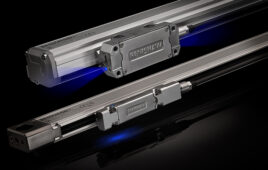
By Nick Bach
If you’ve attempted to implement an ultra-high frequency (UHF) RFID system into your facility, you might have run into some headaches in the process of getting things to work properly. If you are looking to implement UHF RFID but haven’t had the chance to set things up yet, then this blog might be beneficial to keep in mind during the process.
UHF RFID and what it can do
UHF RFID is a long-range system with a focus on gaining visibility in the supply chain or manufacturing process. It can track multiple ID tags in a set area/distance (depending on the read/write head you select). The RFID field is emitted by an antenna that propagates an electromagnetic field, which will “ping and power up” a tag with data saved on it. Commonly, warehouses use it for logistics, supply chain tracking, warehouse pallet tracking, equipment tracking, or even for luggage tracking. As amazing as this technology sounds, there are environmental factors that can cause the system to not work to its full potential.
Factors affecting RFID system performance
Different materials or environments can affect the performance of your RFID system. Each tag antenna is set to a specific frequency, and some materials or environments can influence the radiation pattern. This can be something as simple as the material on which the tag is mounted to something more complex, such as how the signal is going to bounce off the walls or the ground. Below are some common issues people run into when implementing RFID.
- Absorption: Absorption occurs when an object in the field absorbs part of the radio frequency energy emitted from the reader antenna. Cardboard, conductive liquids, and tissue (human bodies or animals) are examples of materials that can absorb some of the RF energy. One way to think of this is to imagine a sound booth in a recording studio. The booth is covered in foam to absorb sound. This is a similar philosophy for UHF RFID. You need to consider materials that absorb that energy.
- Reflection: When there are distortions of the RF field, reflection can occur. As you may imagine, certain materials, such as metals, can cause the waves emitted from the antenna to distort or “reflect” in ways that cause performance losses. This could be metal machinery or fixings between the reader and the tags, a group of metal pipes, and mounting on metal containers. If you choose to do a deeper dive, there are other performance factors that can be impacted by the path of the signal, such as zones in which the tag can’t be reached (even if the tag is in the reader’s field), or the tag and the reader are not aligned properly.
- Detuning: Detuning occurs when the radio frequency between the tag and reader is changed in the process. Since you pair specific readers to specific tags at a specific frequency, you don’t want your environment to cause a change in the specific frequencies. Certain materials, such as cardboard, metals, tissue, and plastics, can cause an impedance that can “un-match” your reader and tags based on the RF not matching up.
Luckily for you, many companies who specialize in RFID can help ensure you pick the right system for your application. Some will even go visit your site to evaluate the environment and materials that will be involved in the process and recommend the right readers, antennas, tags, and accessories for you.
Although not all UHF RFID applications seem complex, there are many small things that can affect the entire operation. When you are picking your system, make sure you keep in mind some of these effects, and if you are unsure, call in a professional for some assistance.
Click here for more information about reliable tracking.
Nick Bach is a technical sales trainee for Balluff.
Sponsored content by Balluff
Filed Under: Balluff Sponsored Content




